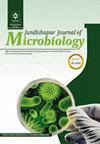从中国热带海南省人类和环境来源中分离的四株 Mcr-1 大肠埃希菌的基因组特征和抗菌药耐药性
IF 0.5
4区 医学
Q4 MICROBIOLOGY
引用次数: 0
摘要
背景:对多种药物产生耐药性的革兰氏阴性细菌迅速蔓延,尤其是耐碳青霉烯类药物菌株的增加,已导致临床环境中的耐药性达到临界水平。可乐定被认为是抵抗这些革兰氏阴性菌的最后一道防线。研究目的本研究旨在调查来自中国热带海南省不同来源的四株 mcr-1(移动性可乐定耐药性)大肠埃希菌分离株的遗传特征和抗菌药耐药性(AMR)模式,并确定它们与国内和全球菌株的遗传关系。研究方法样本采集自中国海南省海口市和三亚市的游泳池、海水浴场和海滩工作人员。获得大肠杆菌分离株,进行多焦点序列分型,并通过聚合酶链式反应扩增 mcr 家族抗性基因。分析了 mcr-1 菌株的移动序列、AMR 基因、表型和毒力基因型。对 mcr-1 大肠杆菌菌株与 NCBI 数据库中的菌株之间的关系进行了系统发育分析。结果在本次研究中,有 4 株菌株检测到 mcr-1 耐药基因,占总数的 2.94%(4/136)。这 4 株大肠杆菌分别从淡水游泳池、池壁、海水和人体中分离出来。这 4 株菌株对多粘菌素的最低抑菌浓度为 8 毫克/升,只有一株菌株对多粘菌素的最低抑菌浓度为 4 毫克/升,表现出低水平的抗药性。四株菌株均对氨苄西林完全耐药,三株对复方磺胺甲噁唑和氯霉素耐药,所有菌株均对其他常见抗生素敏感。在所有大肠杆菌菌株中都检测到了毒力基因 cfaA、cfaB、cfaC 和 cfaD/cfaE。可插入序列 IS3 是分布最广的类型。三个分离物被鉴定为 ST987,而来自海洋的分离物被鉴定为 ST24。菌株核心基因的比较表明,这四株菌株与泰国北部的 Chrysomya sp.结论四种 mcr-1 基因可介导中低水平的可乐定抗性,促进其在人群和环境中的传播。在与人类直接接触的娱乐用水中追踪耐多药细菌的来源,并通过有效监管降低对人类健康的风险至关重要。本文章由计算机程序翻译,如有差异,请以英文原文为准。
Genomic Characterization and Antimicrobial Resistance of Four Mcr-1 Escherichia coli Strains Isolated from Human and Environment Sources, Hainan Province, Tropical China
Background: The rapid spread of multidrug-resistant gram-negative bacteria, particularly the increase in carbapenem-resistant strains, has led to a critical level of resistance in clinical settings. Colistin is considered to be the last line of defense against these gram-negative bacteria. Objectives: This study aims to investigate the genetic characteristics and antimicrobial resistance (AMR) patterns of four mcr-1 (mobile colistin resistance) Escherichia coli isolates from various sources in Hainan Province, tropical China, and to determine their genetic relationships with both domestic and global strains. Methods: Samples were collected from swimming pools, marine beaches, and beach personnel in Haikou and Sanya, Hainan Province, China. E. coli isolates were obtained, multilocus sequence typing was performed, and the mcr family resistance genes were amplified by polymerase chain reaction. The mobile sequences, AMR genes, phenotypes, and virulence genotypes of the mcr-1 strains were analyzed. Phylogenetic analyses were conducted to investigate the relationships between the mcr-1E. coli strains and those in the NCBI database. Results: In the current study, the mcr-1 resistance gene was detected in 4 strains, accounting for 2.94% (4/136) of the total. The 4 strains of E. coli were isolated from a freshwater swimming pool, a pool wall, seawater, and a human body. Among the four strains, the minimum inhibitory concentration of polymyxin was 8 mg/L, except for one strain, which showed low-level resistance at 4 mg/L. All four strains showed complete resistance to ampicillin, three were resistant to compound sulfamethoxazole and chloramphenicol, and all strains were sensitive to other common antibiotics. The virulence genes cfaA, cfaB, cfaC, and cfaD/cfaE were detected in all E. coli strains. The insertable sequence IS3 was the most widely distributed type. Three isolates were identified as ST987, whereas the isolate from marine sources was identified as ST24. Comparison of the core genes of the strains indicated that the four strains were closely related to the Chrysomya sp. from Northern Thailand. Conclusions: The four mcr-1 genes can mediate low to medium levels of colistin resistance, facilitating their dissemination within the population and the environment. It is crucial to trace the source of multidrug-resistant bacteria in recreational water, which is in direct contact with humans, and to reduce the risks to human health through effective supervision.
求助全文
通过发布文献求助,成功后即可免费获取论文全文。
去求助
来源期刊

Jundishapur Journal of Microbiology
MICROBIOLOGY-
CiteScore
1.30
自引率
0.00%
发文量
56
审稿时长
6-12 weeks
期刊介绍:
Jundishapur Journal of Microbiology, (JJM) is the official scientific Monthly publication of Ahvaz Jundishapur University of Medical Sciences. JJM is dedicated to the publication of manuscripts on topics concerning all aspects of microbiology. The topics include medical, veterinary and environmental microbiology, molecular investigations and infectious diseases. Aspects of immunology and epidemiology of infectious diseases are also considered.
 求助内容:
求助内容: 应助结果提醒方式:
应助结果提醒方式:


